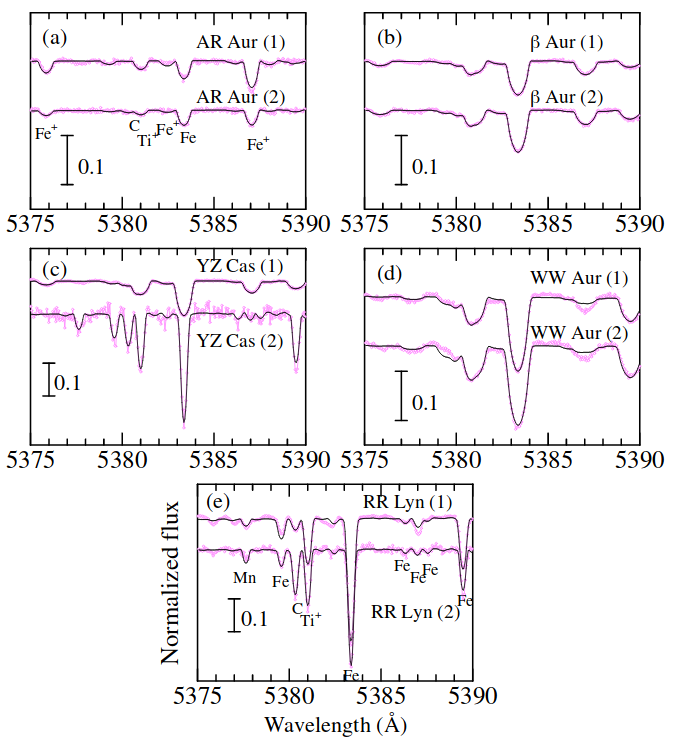
In a recent submission to the Monthly Notices of the Royal Astronomical Society (MNRAS), astronomers described their findings about the compositional differences between the components of eclipsing close binary systems showing chemical peculiarities. A binary system is one in which which there are two objects orbiting around their common center of mass. An eclipsing binary is a particular type of binary system in which the line of sight of the observer relative to the orbital plane of the system shows that periodically the combined light of the objects is temporarily dimmed by one object passing in front of the other (see Figure 1). These systems can take on various parameters. For example, the components that make up the system could be any number of objects, such as main sequence stars, red giants, white dwarfs, neutron stars, etc. Also, the distance between the components can vary greatly from system to system. In some systems, the components are very far apart (detached) while in others they touching (contact) as in Figure 1 above.

One of the unsettled issues in astronomy is regarding chemically peculiar stars (CP stars). As the name suggests, these stars have some anomalies in their spectrum that distinguish them from other main sequence stars. While astronomical spectroscopy is an in-depth topic, essentially the light from an object will sometimes show lines in its spectrum that reveal the object's chemical properties. One of the key things astronomers are looking for is the abundance of carbon, nitrogen, and oxygen because these are essential elements for nucleosynthesis in stars.In the case of CP stars, an example would be an 'Am star' whose spectra shows absorption lines of metals such as zinc, strontium, zirconium, and barium. Another example of a CP star is a 'HgMn' (mercury-manganese) star that has a strong ionized mercury spectral line and a specific deficit of other types of elements.
In this study, data was obtained over 5 nights using the spectrograph on the 1.8 meter reflecting telescope at Bohyunsan Astronomy Observatory in Korea. The target star systems were: AR Aur, beta Aur, YZ Cas, WW Aur, and RR Lyn. The goal was to extract the individual spectra for the both the primary and secondary star of each system. The raw data collected were reduced with normal techniques that eliminate noise, such as bias subtraction, flat fielding, etc. Furthermore, because these systems have two components, the spectra had to be 'disentangled' from each other so the astronomers would know which chemical properties belong to which star.
The spectra found for each component (primary and secondary) of each target are shown in Figure 3 below. Beta Aur and WW Aur have 'similar components', meaning that the spectra for both the primary and secondary are nearly identical. On the other hand, YZ Cas and RR Lyn have different components, meaning there are significant differences between the spectra. The authors suggest that temperature may play a role in determining which anomaly appears in the spectrum. The components of close eclipsing binaries tend to slow each other down due to the mutual influence of their gravity (i.e., tidal breaking), and this slow rotation is thought to give rise to the Am anomaly. However, it appears there may be a lower limit of about 7,000K below which the anomaly cannot be produced. Furthermore, it is possible that as the temperature rises to about 10,000K the Am anomaly transitions to the HgMn anomaly. Further research in this area is critical in determining how the appearance of CP stars depends on the characteristics of their components.

References
Yoichi, T. et al. (2019). https://arxiv.org/pdf/1902.04766.pdf
This post has been voted on by the SteemSTEM curation team and voting trail in collaboration with @curie.
If you appreciate the work we are doing then consider voting both projects for witness by selecting stem.witness and curie!
For additional information please join us on the SteemSTEM discord and to get to know the rest of the community!
Congratulations @ptsouth97! You have completed the following achievement on the Steem blockchain and have been rewarded with new badge(s) :
Click here to view your Board
If you no longer want to receive notifications, reply to this comment with the word
STOPTo support your work, I also upvoted your post!
Do not miss the last post from @steemitboard: